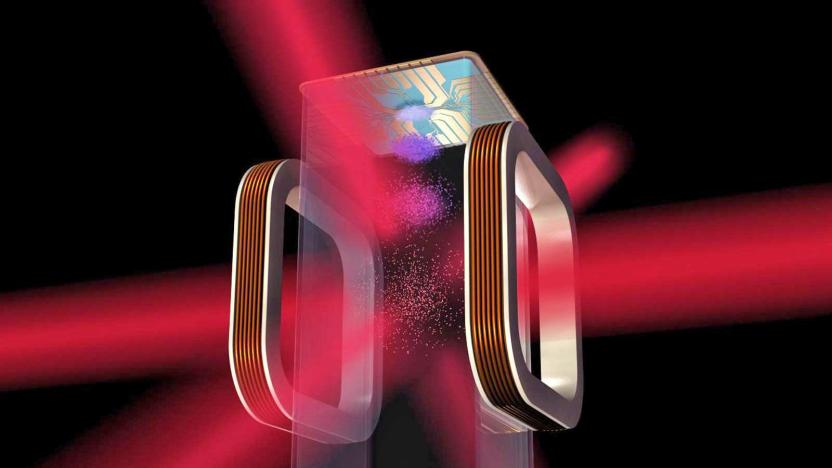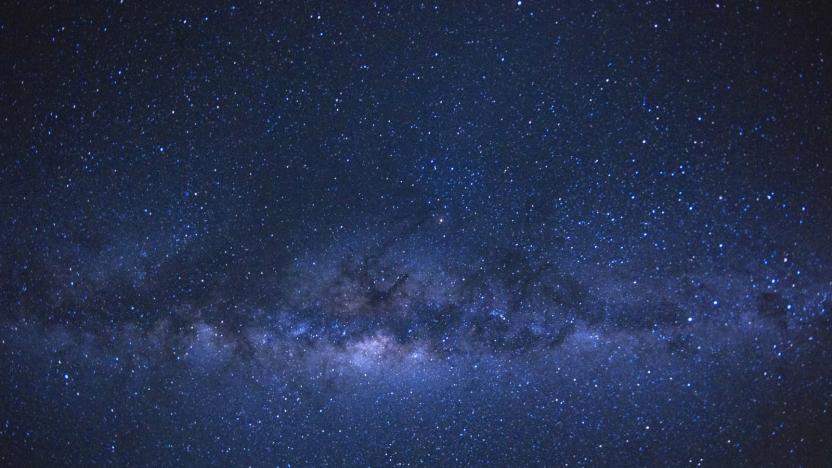darkenergy
Latest

NASA will create coldest place in the universe to study quantum physics
It's hard to study quantum behavior on Earth. You can amplify the effects of quantum mechanics by zapping groups of specific atoms (Bose-Einstein condensates) with lasers that drop their temperature to near absolute zero, but that only works for fractions of a second before gravity invariably takes over. NASA's solution? Create the coldest known place in the universe. The agency just launched the Cold Atom Lab, a box that takes advantage of microgravity aboard the International Space Station to keep condensates in that ideal state for much longer.

Physicists keep striking out in the search for dark matter
Space may be the final frontier, but we've barely begun to explore its underlying mechanics. For as much as humanity has discovered since we first looked to the heavens, we've only seen about five percent of the total matter in the universe. The other 95 percent -- the so-called "dark matter" -- well, we can't even figure out how to see yet. But that doesn't mean researchers from around the world aren't devising ways to do so.

The Dark Energy Spectroscopic Instrument will 3D map the universe
The quest to better understand our known universe took a step in the right direction today with the U.S. Department of Energy approving "Critical Decision 2," authorizing the building of components for the Dark Energy Spectroscopic Instrument (DESI). Previous efforts to create Dark Energy maps will be further explored with the help of the DESI, a giant instrument that will target 30 million galaxies and quasars to create a 3D map that will date back 10 billion light-years. The project, spearheaded by the University of Michigan, is being conducted to understand the fundamentals of Dark Energy, a force that competed with gravity to shape the universe in its infancy.

Scientists create dark matter 'map' to see invisible space
We've finally gotten our first glimpse at the mysterious material that supposedly makes up 27 percent of the universe. It's only taken two years of research, the efforts of 300 researchers working for the Dark Energy Survey (DES) and a 570-megapixel camera attached to the Victor Blanco telescope in Chile to do so. Their findings, in the form of a map, are expected to be released at a meeting of the American Physical Society tomorrow. Well, "map" is a bit of a misnomer dark energy can only be observed indirectly, through the lensing effect that it has on stars and galaxies.

Supernovae suggest the universe is growing slower than expected
Don't look now, but what you know about the universe's growth might have been turned on its ear. University of Arizona scientists have learned that a certain type of supernova (Ia) isn't the reliable measuring stick for universe expansion that previous data would suggest. By comparing optical and ultraviolet images (such as in the hybrid image you see above), they found that older, farther exploding stars aren't behaving in the same way as newer ones closer to our own star. In other words, the ancient supernovae aren't necessarily as distant as you'd think -- and if they aren't, the universe isn't growing as quickly as textbooks say.

DECam: Gazing deep into the final frontier in search of dark energy
The National Optical Astronomy Observatory (NOAO) puts it into perspective right away: "Eight billion years ago, rays of light from distant galaxies began their long journey to Earth." It's important to hold that fact in mind, as we marvel at the first images from deep in the belly of our universe to arrive from the Chile-based Dark Energy Camera (DECam). As that name might suggest, peering at remote galaxies for purely visual gratification isn't the camera's primary purpose. The result of eight years of planning and hard work, involving engineers and scientists from three continents, the DECam is mounted on the Victor M. Blanco Telescope at the Cerro Tololo Inter-American Observatory in Chile. Sitting atop a 7,200-foot mountain, the camera is part of the Dark Energy Survey, which intends to gather information on over 300 million galaxies. The goal is to better understand dark energy -- a concept that represents our best explanation for why the universe's rate of expansion is speeding up, rather than slowing due to gravity. Gaze past the break for the background on the project.

Scientists release biggest ever 3D map of the universe, lacks turn-by-turn navigation (video)
The stargazers at the Harvard-Smithsonian Center for Astrophysics have released a huge three-dimensional map of outer space, a core part of its six-year survey of the skies. Encompassing four billion light-years cubed, the researchers hope to use the map to retrace the movements of the universe through the last six billion years. Using the latest Sloan Digital Sky Survey (SDSS-III), the center says the data will help improve their estimates for the quantity of dark matter in space and the effect that dark energy has on the universe's expansion, "two of the greatest mysteries of our time" -- if you're an astrophysicist. Even if you're not, you'll still want to board the animated flight through over 400,000 charted galaxies -- it's embedded after the break.




